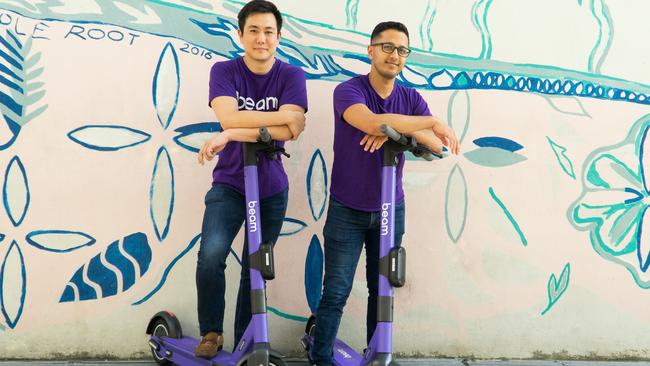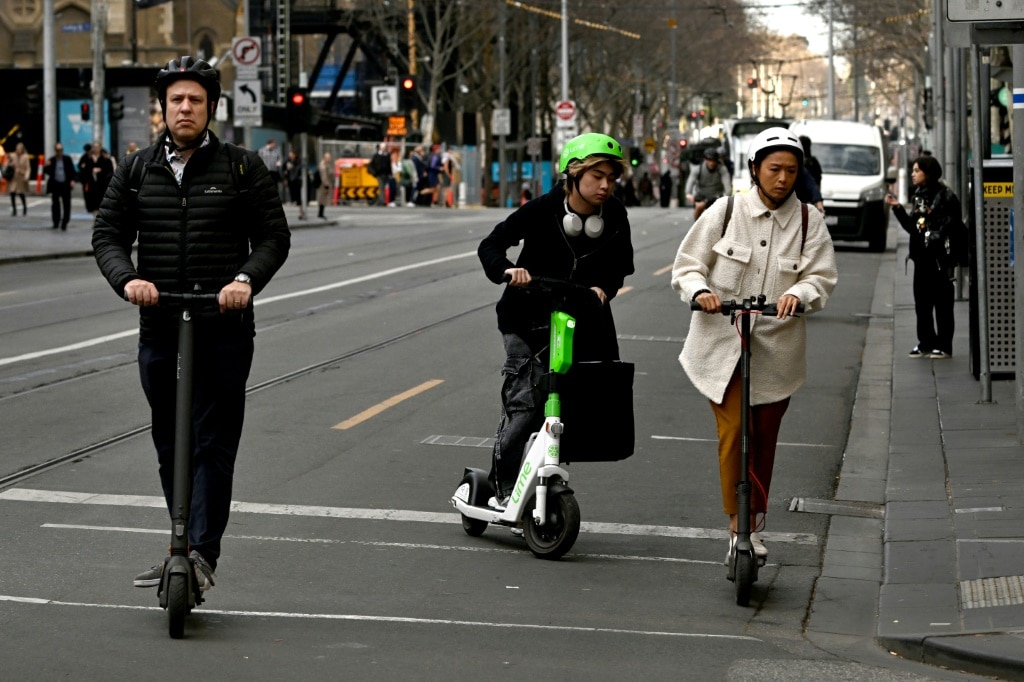‘Running Hot Project’: e-scooter firm Beam accused of audacious scam
Global e-vehicle company, Beam Mobility, has allegedly been putting ‘phantom’ scooters on the streets of cities across Australia and New Zealand to cheat governments out of millions of dollars in fees and subvert safety limits.

Global e-vehicle company Beam Mobility has allegedly put “phantom” scooters on streets in Australia and New Zealand to cheat governments out of potentially hundreds of thousands of dollars in fees and subvert safety caps.
The fast-growing, Singapore-based operator is under investigation by at least five local governments, including Brisbane, Auckland and Canberra, for manipulating monitoring technology to exceed caps on the number of scooters and bikes allowed.
For the right to be licensed in a city, e-scooter companies are supposed to pay registration fees on each vehicle and/or a percentage of a fare paid by riders.
The local governments are investigating allegations Beam deliberately went over the cap of scooters – in some places by as much as 30 per cent – depriving them of potentially thousands of dollars per day in lost revenue.
In an extraordinary statement to The Weekend Australian on Friday night, Beam Mobility chief executive Alan Jiang said the company was “deeply apologetic” for exceeding vehicle allocations but insisted it was unintentional and “emphatically reject(ed) any suggestion that this was a ‘scheme’ to deprive councils of revenue”.
A whistleblower, who declined to be named, said Beam had deliberately “cooked up” the scheme to get “an additional 1500 vehicles over cap” to generate thousands of dollars in extra revenue per day.
The Weekend Australian has obtained a cache of emails and internal messages from the company’s “war-room”, Slack chat, exchanged by senior executives including its two Yale University graduate founders, and reveals the inner-workings of the scheme, internally dubbed the “Running Hot Project” which allegedly delivers fake, real-time data to an independent monitoring app that tracks the numbers of vehicles and trips.
Local governments have been separately provided with the internal documents, which The Weekend Australian understands are forming part of the investigations.
The monitoring app, Ride Report, has also confirmed it is investigating the allegations against Beam. It has already reviewed historical data in the affected cities to “quickly identify patterns within the data that are consistent with the concerns” raised by The Weekend Australian.
Established in 2018, Beam operates in more than 60 cities globally, with booming market shares in Turkey, Japan, Indonesia, Malaysia, Thailand and South Korea.
Their scooters and bikes are in 37 locations in Australia and New Zealand, including Sydney, Perth, Darwin, Adelaide, Cairns, Townsville, Hobart and regional towns in every state.
Sources have said there are suspicions the alleged fraudulent scheme could have spread further internationally.
In April, Beam announced publicly that its profits had increased 36 per cent to a record $US53m for 2023.
The leaked correspondence reveals Beam president Deb Gangopadhyay – named with co-founder Mr Jiang in Forbes’ 30 under 30 for consumer technology in Asia in 2019 – emailed his team on April 17 last year, pitching a “risk-taking” initiative to increase deployed vehicles in cities by “adjusting” the definitions of publicly reported data provided to Ride Report.
“The value could be quite high and immediate,” Mr Gangopadhyay told his colleagues, estimating the number of deployed vehicles could be hiked by up to 20 per cent with “high certainty”.
“I think we should execute this with high urgency once aligned.”
Mr Gangopadhyay suggests some operational vehicles could be marked as unrideable, unknown, or having low battery – so they don’t appear as “available” on the app – but warns “we need to be careful as that vehicle could get trips but not show up as a vehicle (in Ride Report) – so easy to flag”.
In another email on May 29, Mr Gangopadhyay writes that marking scooters as “unknown” is “promising in that it seems to remove vehicles altogether from Ride Report”, but warns if a lot of “unknown” vehicles are being ridden by customers “that might be a yellow flag”.
He suggests that some scooters could be marked as unknown if they had “no ride for x hours”, and he asked whether a Ride Report executive would be “supportive of us having definitions that help us deploy a little more?”
Tom Cooper, the company’s Australia, New Zealand and US regional general manager, replied and said he did not believe the executive would be supportive.
“He takes his role as the watchdog seriously and in the end cities are his clients,” Mr Cooper said.
In the Slack “war room” chat on July 18 last year, Beam’s Sydney-based global director of corporate development Ashan Sanjeeva said he and Mr Cooper had set targets for each city as “requested space between Ride Report and actual DV (deployed vehicles).”
Mr Sanjeeva said Brisbane’s target was 350 extra vehicles, 150 in Canberra, 100 in Townsville, 300 for Auckland and 100 for Wellington.
He repeatedly raises a “risk” in Brisbane “should a council inspector come across a hidden vehicle and check RR to see if company deployed or user parked, they will not find the answer – as I understand the situation – and there may be a question raised”.
On August 5 last year, Beam’s Melbourne-based group general counsel and chief commercial officer Khoa Pham told the 20-member Slack “war room” chat to alter the internal figures included in a daily company-wide email to match the Ride Report data.
“Hey guys. Could we optimise the daily email as well so the (internal) dev is consistent with the RR dv (deployed vehicles figure). That goes to the whole company,” he said.
Throughout the internal correspondence, the strategy to increase the number of scooters on the ground is referred to as “optimisation”.
In a statement, Michael Schwartz of US-based INRIX, the parent company of Ride Report, said in the past fortnight Ride Report staff were made aware of “concerns” Beam was creating data inconsistent with international standards.
“Once councils told Ride Report of these concerns, staff immediately reviewed historic Beam data in all markets where Ride Report has data. Fortunately, the data driven approach taken by most councils in Australia and New Zealand meant Ride Report had stored a digital paper trail of Beam’s activities, so staff were able to quickly identify patterns within the data that are consistent with the concerns cited in your email,” Mr Schwartz said.
In the written statement from Beam Mobility, Mr Jiang said the company had “taken an approach” of marking certain vehicles as “unknown” or inactive in the Ride Report app, and then deployed extra vehicles to ensure “there was an adequate number of usable vehicles available to the public within the limits of the agreed terms with councils and Ride Report’s system”. “However, as a result of this approach there have been instances where we have exceeded the vehicle allocation,” Mr Jiang said.
“While this was never our intention, it is something that we take seriously and are deeply apologetic for. We understand the importance of our social licence in our key markets and recognise that we need to do better in the future to meet the high standards our partners set for us. We emphatically reject any suggestion that this was a ‘scheme’ to deprive councils of revenue.”
He said the company would fully revise its processes to make sure it did not happen again, conduct an internal review, appoint an independent auditor, and deliver a preliminary report by the end of next month.
“We are prepared to negotiate a commercial settlement with any councils affected for any issues around noncompliance of our licence,” he said.
The ACT government, and councils in Brisbane, Townsville, Auckland and Wellington have confirmed to The Weekend Australian they are all investigating allegations of “unethical behaviour” by Beam. All five of the local government areas use the Ride Report app to monitor compliance with their scooter schemes.
Brisbane City Council Civic Cabinet chair for transport Ryan Murphy said a council-led investigation was launched on August 2 and remained under way.
“We are aware of these allegations and are taking them very seriously,” Mr Murphy said. “Until these claims are proven, they remain allegations, and any findings will be passed on to the appropriate authorities.
“I want to assure the public there are no operational or safety concerns with Brisbane’s shared scooter scheme.”
In Brisbane, where Lime and Beam have a maximum cap of 6000 vehicles total, the council’s latest contract with the companies requires a fee-per-trip to be paid to the local government, rather than the former pay-per-vehicle arrangement.
The city’s most recent annual report shows 3,649,897 e-mobility trips were taken in Brisbane in 2022-23.
Auckland Council licensing and environmental health manager Mervyn Chetty said the council had carried out an investigation into allegations Beam had breached the vehicle limits in its micromobility licence, which caps the number of scooters at 1400.
“We have carried out an investigation and have given Beam until the end of this week to respond to our concerns,” Mr Chetty said.
The council in Townsville – where Beam is has a cap of 300 scooters, excluding the area around the James Cook University campus in the north Queensland city – said it had asked Beam to respond to the allegations.
In Wellington, where Beam is licensed to deploy a maximum of 500 e-scooters and 150 e-bikes, the council charges Beam an annual company trading licence fee of $615, and 11c per trip. In Canberra, where Beam started operating in 2020, an ACT government permit allows Beam a cap of 950 e-scooters, for which the council collects $1 per vehicle per day in the centre of the city, and 50c per vehicle per day used in regional areas.
Do you know more? Contact
us confidentially at: mckennam@theaustralian.com.au or elkss@theaustralian.com.au





To join the conversation, please log in. Don't have an account? Register
Join the conversation, you are commenting as Logout